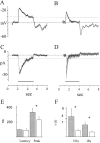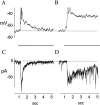Origin of transient and sustained responses in ganglion cells of the retina
- PMID: 10995856
- PMCID: PMC6772807
- DOI: 10.1523/JNEUROSCI.20-18-07087.2000
Origin of transient and sustained responses in ganglion cells of the retina
Abstract
Phasic and tonic light responses provide a fundamental division of visual information that is thought to originate in the inner retina. However, evidence presented here indicates that this duality originates in the outer retina. In response to a steady light stimulus, the temporal responses of On-bipolar cells fell into two groups. In one group, the light response peaked and then rapidly declined (tau approximately 400 msec) close to the resting membrane potential. At light offset, these cells exhibited a transient afterhyperpolarization. In the second group of On-bipolar cells, the light response declined 10-fold more slowly and reached a steady depolarization that was approximately 40% of the peak response. These neurons had a slowly decaying afterhyperpolarization at light offset. A metabotropic glutamate antagonist, (RS)-alpha-cyclopropyl-4-phosphonophenylyglycine (CPPG), blocked light responses in both types of On-bipolar cell. CPPG only slightly depolarized transient On-bipolar cells, whereas sustained On-bipolar cells were significantly depolarized. Inorganic calcium channel blockers disclosed that these distinct On-bipolar responses were inherent to the bipolar cell and not attributable to synaptic feedback. CPPG had distinct effects on sustained and transient ganglion cells, similar to its action on bipolar cells. The antagonist depolarized and blocked the light responses of sustained ganglion cells. In transient ganglion cells, CPPG suppressed the On light response but did not depolarize the cell or block the Off light response. These results suggest that transient and sustained light responses in ganglion cells result from selective bipolar cell input and that these two fundamental visual channels originate at the dendritic terminals of bipolar cells.
Figures











References
-
- Barnes S, Werblin F. Direct excitatory and lateral inhibitory synaptic inputs to amacrine cells in the tiger salamander retina. Brain Res. 1987;406:233–237. - PubMed
-
- Bieda M, Copenhagen DR. Inhibition is not required for the production of transient spiking responses form retinal ganglion cells. Vis Neurosci. 2000;17:243–254. - PubMed
-
- Boycott B, Wassle H. Parallel processing in the mammalian retina: the Proctor Lecture. Invest Ophthalmol Vis Sci. 1999;40:1313–1327. - PubMed
-
- Cook PB, McReynolds JS. Lateral inhibition in the inner retina is important for spatial tuning of ganglion cells. Nat Neurosci. 1998;1:714–719. - PubMed
-
- Dacheux RF, Frumkes TE, Miller RF. Pathways and polarities of synaptic interactions in the inner retina of the mudpuppy: I. Synaptic blocking studies. Brain Res. 1979;161:1–12. - PubMed
Publication types
MeSH terms
Substances
Grants and funding
LinkOut - more resources
Full Text Sources
